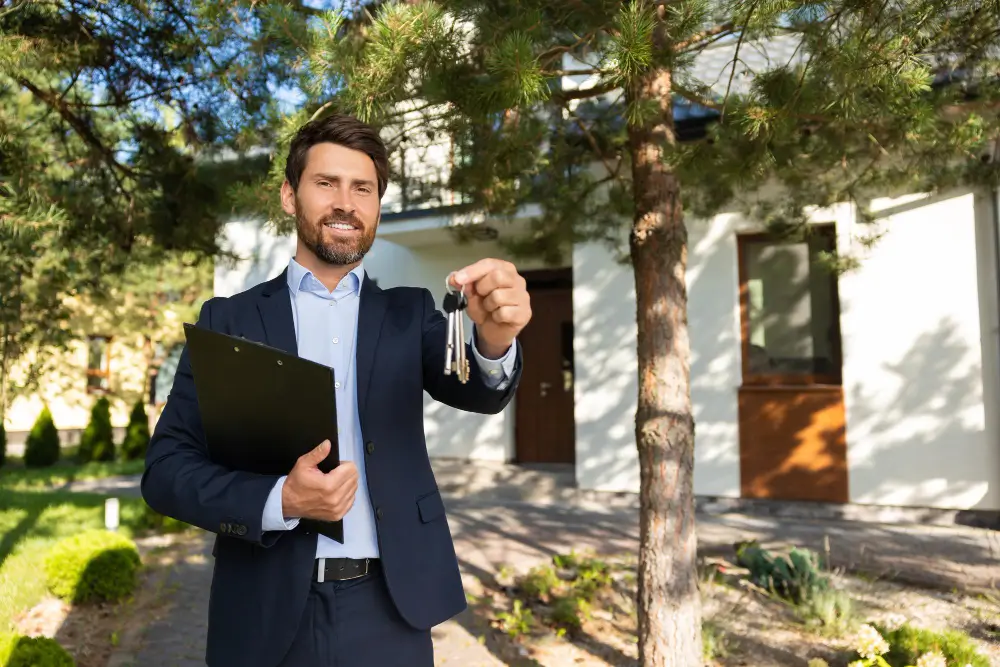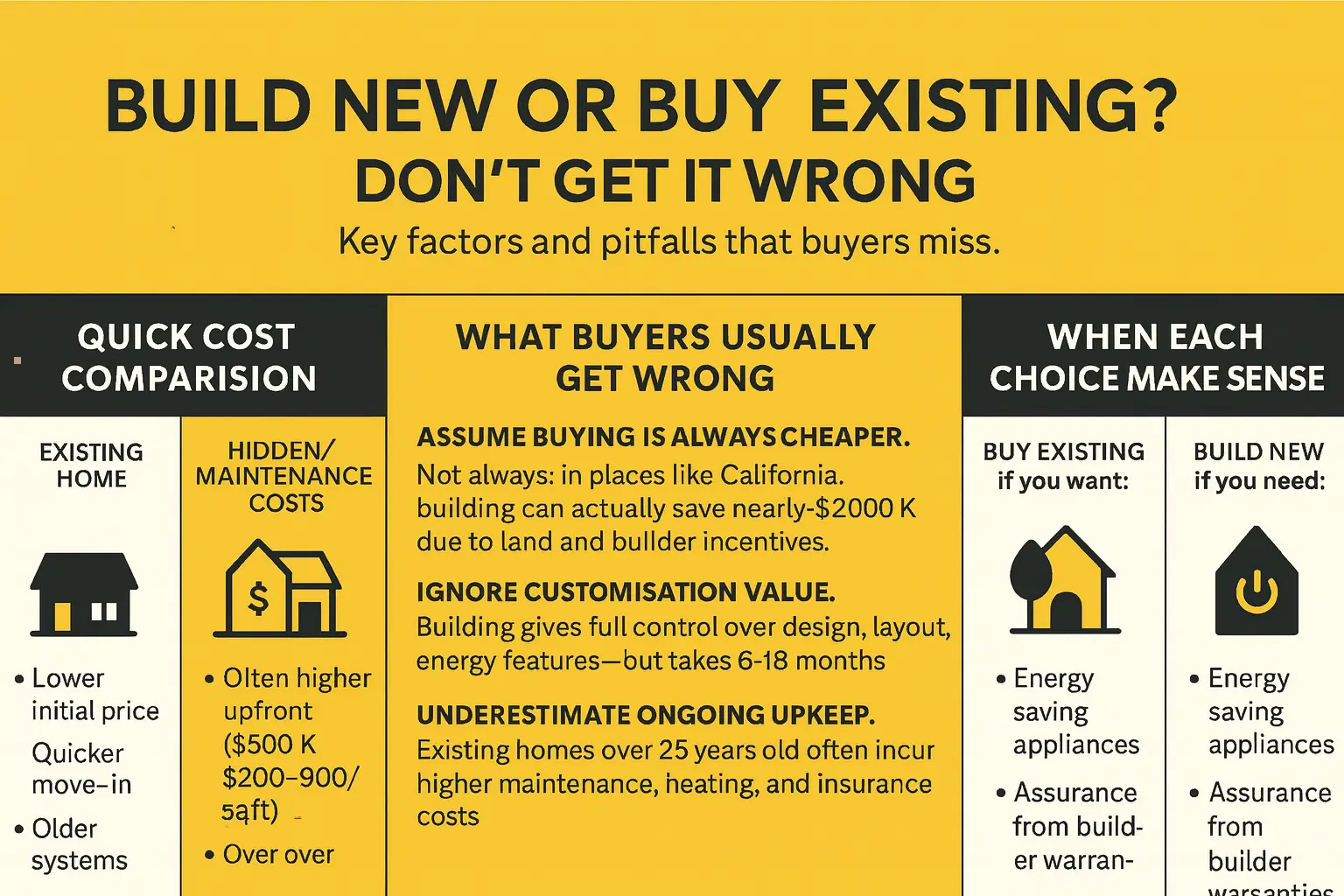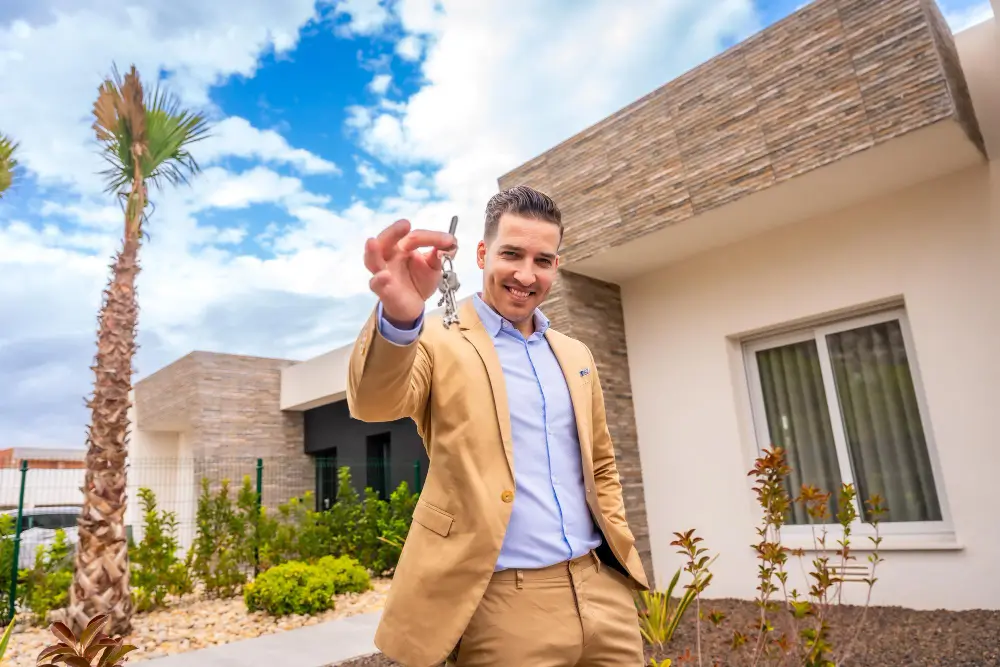TL;DR: Buying an existing home gives you speed, location, and predictability, but often comes with compromises and maintenance costs. Building allows full customisation, though it usually means delays, cost overruns, and living further from established amenities. The better choice depends on your timeframe, budget flexibility, and long-term goals.
Key Takeaways:
- Existing homes are quicker to move into and easier to finance but may require costly repairs.
- Building offers a tailored living space, though construction delays and budget blowouts are common.
- Location quality tends to favour existing properties, while new builds may lack nearby infrastructure.
- Consider lifestyle, market trends, and resale value when weighing both options.
Buying property is one of the biggest decisions you’ll make. One question keeps popping up for would-be homeowners and investors: Is it better to buy an existing home or build a new one?
On paper, it seems straightforward. But when you factor in rising costs, timelines, lifestyle needs, and long-term value, the answer isn’t so simple.
This guide lays it all out so you can make the best choice for your goals.
You’ll Pay Differently, But Not Always How You Think
Existing Homes Come With Upfront Price Certainty
With existing homes, the price, location, and general condition are known from the start.
While you might need to budget for some renovations or maintenance, the overall financial picture is clearer than most alternatives. You’re not guessing what the final cost will be.
Building Sounds Cheaper, Until It Isn’t
House and land packages can appear more affordable at first glance, particularly with the help of government grants or promotional deals. However, costs during construction often shift:
- Shortages of timber, steel, and key materials can delay builds and drive up prices
- Labour shortages or scheduling conflicts may stall progress or raise labour costs
- Design tweaks or changes during construction often lead to unexpected fees and extended timelines
It’s not uncommon to see new builds exceed their estimated costs by tens of thousands. And that’s before landscaping, fencing, or driveways are factored in.

Timeframes Can Make or Break Your Plans
Buying Is (Usually) Faster
If you’re working with a specific deadline, such as relocating for a new job or trying to avoid rising rental expenses, buying an established home often makes more practical sense.
The settlement process is generally predictable and can be completed in 30 to 90 days, giving you a clearer timeline for moving in.
Building Can Drag On
Constructing a new home typically takes between 9 to 12 months. But unexpected delays can push that timeline well beyond a year.
Factors like weather, trades availability, and council approvals can all contribute to slower progress. If you’re paying rent while waiting, those additional months can significantly increase your overall outlay.
On top of that, the uncertainty around completion dates adds extra pressure.
The Lifestyle Trade-Offs No One Talks About
Buying Means Compromising
You might find the perfect neighbourhood but be stuck with a kitchen that needs an overhaul. Or the layout may feel awkward for your family’s needs as time goes on.
With established homes, there is often a trade-off between location and functionality. Renovations can help, but they come with added cost and disruption.
Building Is Tailored but Location May Suffer
Designing a home from scratch gives you control over the layout, finishes, and overall feel. You can plan a space that works precisely for your lifestyle, which is a major draw for many buyers.
However, building often comes with location trade-offs:
- New developments are usually situated in outer suburbs
- Local amenities such as schools and shops may be limited or still under construction
- Public transport options can be minimal, increasing reliance on cars
The home might suit your needs perfectly, but the surrounding infrastructure could take years to fully develop.
Long-Term Value: What Are You Really Getting?
Older Homes Have Proven Value
Character homes in well-established suburbs tend to retain value more consistently over time. Their proximity to schools, transport, and shopping precincts makes them appealing to a wide range of buyers.
In many cases, the land they sit on is just as valuable as the home itself, especially in tightly held locations where space is limited.
New Builds Age Fast
While a new home feels fresh and modern initially, that advantage fades quickly. Within a few years, the property becomes just one of many similar houses in a large, expanding estate.
If demand in the area flattens or supply increases too quickly, price growth can stall. The home might still be in good condition, but it may lack the unique appeal that drives long-term capital growth.
Maintenance: A Hidden Cost to Watch
Existing Homes Need Upkeep
Older homes, particularly those built decades ago, often carry hidden maintenance needs. Buyers should factor in potential repair costs when setting their budget. Some common issues include:
- Worn-out plumbing that may cause leaks or water pressure problems
- Outdated electrical systems that might not meet current safety standards
- Roofs that may need replacement due to age or weather damage
New Builds Are Low-Maintenance (At First)
New properties typically offer a smoother start with fewer immediate repairs. Most come with builder warranties that cover structural or system defects for several years.
However, not all new homes are built with the same level of care. If corners were cut or cheaper materials were used, problems like cracking walls or plumbing faults could appear sooner than you’d hope.
Financing Can Be Tricky
Loans for Existing Homes Are Straightforward
Banks tend to be more confident financing established homes. These properties have known market values, making it easier to complete valuations and determine lending terms.
This gives you a clearer understanding of how much you can borrow and what your repayments will look like from day one.
Construction Loans Are a Different Beast
With construction loans, funding is released in stages as the build progresses. You may need to start repayments before the house is complete, which can be challenging if you’re also covering rent or other housing expenses.
If the final valuation by the bank falls short of your total build cost, you could be required to cover the gap out of pocket.

Real-Life Success Stories from Perth Buyers
With prices rising, low vacancies, and plenty of competition, clients who work with a property buyers agent in Perth often see much better results than going it alone.
★ Five-Star Feedback from Real Clients
Dan & Kate from Perth:
“In the first consultation, Adam was warm and welcoming and took the time to understand our specific needs (purchasing our first investment property on the West Coast). Renae was an absolutely fantastic buyers agent who went above and beyond in securing and negotiating a great property, through to managing and overseeing some light renovations. It was clear Rise Property Buyers took a personal approach that guaranteed we got the solution we wanted.”
Mevrouw Lim:
“Adam and Karin are super friendly and helpful buyers agents. We feel so supported during the process and we managed to secure a beautiful house within a short time despite the crazy market. Highly recommended!”
These reviews show the difference a focused and experienced team can make, especially when navigating tough market conditions or buying from interstate.
Still Unsure? Let’s Chat
Thinking of building your dream home? Goldseal Homes offers fixed-price, custom home solutions backed by transparency and quality craftsmanship.
Whether you’re a first-time builder or upgrading your lifestyle, start your journey with a team that puts clarity and care first.


